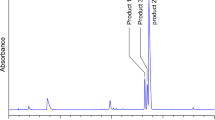Abstract
Cysteine S-conjugates are formed as a result of enzymatic conjugation of xenobiotics with the tripeptide glutathione and subsequent peptidase cleavage. Enzymatic N-acetylation of cysteine S-conjugates yields the corresponding mercapturic acids, which are excreted in the urine. Thus glutathione and cysteine S-conjugate formation are associated with detoxication and excretion of xenobiotics. However, cysteine S-conjugate β-lyase, which is identical to glutamine transaminase K, catalyzes β-elimination reactions of cysteine S-conjugates, yielding a thiolate, pyruvate, and ammonia.
Access this chapter
Tax calculation will be finalised at checkout
Purchases are for personal use only
Preview
Unable to display preview. Download preview PDF.
Similar content being viewed by others
References
Anders, M. W. (1988). Glutathione-dependent toxicity: Biosynthesis and bioactivation of cytotoxic S-conjugates. ISI Atlas of Science: Pharmacology 2, 99-104.
Commandeur, J. N. M., De Kanter, F. J. J., and Vermeulen, N. P. E. (1989). Bioactivation of the cysteine S-conjugate and mercapturic acid of tetrafluoroethylene to acylating reactive intermediates in the rat: Dependence of activation and deactivation activities on acetyl coenzyme A availability. Mol. Pharm. 36, 654 - 663.
Dekant, W., Lash, L. H., and Anders, M. W. (1987). Bioactivation mechanism of the cytotoxic and nephrotoxic S-conjugate S-(2-chloro-1,1,2-trifluoroethyl)-Lcysteine. Proc. Natl. Acad. Sci. USA 84, 7443 - 7447.
Sun, J. D., and Dent, J. G. (1980). A new method for measuring covalent binding of chemicals to cellular macromolecules. Chem.-Biol. Interact. 32, 41 - 61.
Author information
Authors and Affiliations
Editor information
Editors and Affiliations
Rights and permissions
Copyright information
© 1991 Plenum Press, New York
About this chapter
Cite this chapter
Harris, J.W., Anders, M.W. (1991). The Use of 19F NMR in the Study of Protein Alkylation by Fluorinated Reactive Intermediates. In: Witmer, C.M., Snyder, R.R., Jollow, D.J., Kalf, G.F., Kocsis, J.J., Sipes, I.G. (eds) Biological Reactive Intermediates IV. Advances in Experimental Medicine and Biology, vol 283. Springer, Boston, MA. https://doi.org/10.1007/978-1-4684-5877-0_96
Download citation
DOI: https://doi.org/10.1007/978-1-4684-5877-0_96
Publisher Name: Springer, Boston, MA
Print ISBN: 978-1-4684-5879-4
Online ISBN: 978-1-4684-5877-0
eBook Packages: Springer Book Archive




